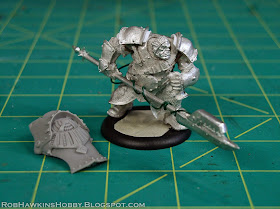Galleries
▼
Thursday, June 26, 2014
Tuesday, June 10, 2014
Faction-Themed Ogrun Bokurs
No Quarter Magazine #54 hit the shelves recently, and it features the next article in a series about converting and painting faction-themed Mercenaries.
This time it's Ogrun bokur. Check out No Quarter for the step-by-step tutorials. Here's a look at how the finished models turned out:
Cygnaran Bokur
Adding some voltaic coils was an obvious choice. This was also a great opportunity to use left over parts from the plastic warjack kits. This bokur's clients have been warcaster and stormsmiths, who over the years have upgraded his halberd with some voltaic tech. The Centurion shield was salvaged from the battlefield and while its magnetic coils don't function anymore it's still sturdy and intimidating. It will also make a nice trophy to go with all the stories he'll tell when returning home.
Parts List:
Plastic Centurion Shield
Stormguard Sgt Voltaic Weapon
MKII Commander Adept Nemo Staff
Khadoran Bokur
The Man-O-War parts are perfectly scaled for bokurs. This ogrun is close to securing a korune, the master he'll permanently swear loyalty to, and so he is wearing Khadoran markings on his armor and shield. Again, the spare plastic Spriggan lance adds a little more character to the model.
Parts List:
Ogrun Bokur
Man-O-War Kovnik Shield
Man-O-War Demolition Corps Right Arm #2
Man-O-War Demolition Corps Left Arm #2
Plastic Spriggan Lance
Cryxian Bokur
I wanted to go a little darker with the Cryxian bokur. The fluff in the Forces book mentions ogrun bringing shame upon themselves by serving dishonorable masters. It doesn't get any more dishonorable than serving the undead. The bokur's hands have been replaced with Brute Thrall gauntlets, likely against his will after suffering a grievous injury. He's now enthralled to the service of the Lich Lords, never to return home.
Parts List:
MKII Pirate Queen Skarre Sword
Lord Exhumator Scaverous Shoulder Armor
Brute Thrall Right Arm
Brute Thrall Left Arm
Seether Carapace
'Til next time!
Saturday, June 7, 2014
Dark Age Demo Tables: LAVA!
For the final installment of this terrain showcase, I'll cover the lava effects on the Dark Age demo tables I made for Cool Mini Or Not. As is normally the case when it comes to crunch time, I start taking fewer pictures as I work. So I don't have any work-in-progress photos of the lava or lighting rig.
The ground was textured with sand and gravel, and painted black. I drybrushed the color up with a mix of P3 Thamar Black and P3 Bloodstone, up through straight Bloodstone, and then added some final highlights with P3 Gun Corps Brown.
Cool Mini Or Not provided some translucent resin crystals to use on the bases. They were imbedded in the ground near the lava. The lava cutouts have a layer of textured plexiglass under them. The plexiglass was protected with tape during the painting, and once the drybrushing was finished, I sprayed some red directly into the center of each lava pool to create a glow on the banks.
Within the base of each table is a series of strip LEDs, positioned to shine up through the crystals and lava.
To create the lava, I tinted some Envirotex Lite (a two-part epoxy) with yellow acrylic paint and poured it into each of the lava pools. Then, before the Envirotex cured, I added the darker swirls around the edges with a cotton swab dipped in orange paint. The paint comes off into the Envirotex without really dissolving, and by swirling it around, I could create some unique effects. For the finishing touch, I dropped a few glass beads into the lava to represent bubbles.
I'm really pleased with the lava; it turned out better than I imagined!
The four tables are designed to function as stand-alone 2' x 2' demo boards...
And also line up to form either a 4' x 4' square, or a 2' x 8' line.
Check out the full range of detail shots in my terrain gallery!
'Til next time!
Wednesday, June 4, 2014
Dark Age Demo Tables: Painting
Cool Mini Or Not held their Expo last weekend. The Dark Age demo tables I built for them made their debut at the show, which means I can show off some painted pictures. To see the table in action, check out the CMON Expo Facebook Page.
To see the construction of the table, check out my post from a few months back: Dark Age Demo Tables: Construction
Painting the Mining Rig
All of the platforms were kept separate for painting. Over a coat of black primer, each one received a spray of successively lighter shades of grey using a mix of Testors and Tamiya sprays. From there, I drybrushed some highlights and added a little silver for wear on the metal deck plates.
The rust was achieved with a mix of P3 Bloodstone and Khador Red Highlight (orange). This was washed into the recesses around the plates, and dappled in places for specific spots of rust.











































